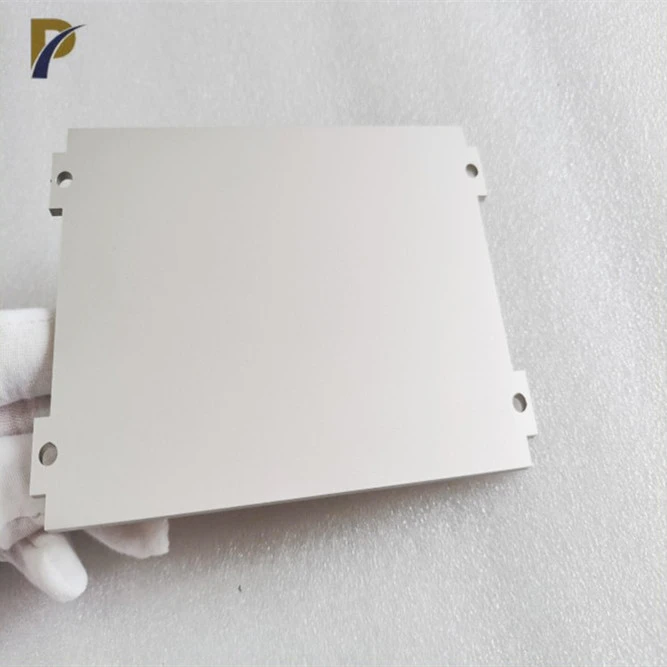Molybdenum copper alloy, a remarkable composite material, combines the unique properties of molybdenum and copper to create a versatile and high-performance alloy. This exceptional blend offers an impressive array of characteristics, including excellent thermal and electrical conductivity, high strength, and superior heat resistance. These properties make molybdenum copper alloy an invaluable material in various industries, from electronics and aerospace to energy production and industrial manufacturing. Its ability to withstand extreme temperatures while maintaining structural integrity and conductivity has revolutionized the design and efficiency of numerous applications, pushing the boundaries of what's possible in modern engineering and technology.
Unique Properties of Molybdenum Copper Alloy
Thermal Conductivity and Heat Resistance
Molybdenum copper alloy exhibits exceptional thermal conductivity, a characteristic inherited from its copper component. This property allows for efficient heat transfer, making it an ideal material for applications requiring rapid heat dissipation. Simultaneously, the alloy demonstrates remarkable heat resistance, attributed to the molybdenum content. This combination enables the material to maintain its structural integrity and performance even under high-temperature conditions, a feature that sets it apart from many other metal alloys.
The thermal expansion coefficient of molybdenum copper alloy is notably low, which contributes to its dimensional stability across a wide temperature range. This attribute is particularly valuable in precision engineering applications where maintaining exact dimensions is crucial, even as temperatures fluctuate. The alloy's ability to resist thermal fatigue further enhances its longevity in cyclical high-temperature environments.
Electrical Conductivity and Resistivity
Another standout feature of molybdenum copper alloy is its excellent electrical conductivity. The copper content imparts high conductivity, while the molybdenum contributes to improved strength and wear resistance. This unique combination allows for the creation of electrical components that can handle high current densities without compromising on mechanical properties. The alloy's low electrical resistivity ensures minimal energy loss during transmission, making it an efficient choice for various electrical applications.
Interestingly, the electrical properties of molybdenum copper alloy can be fine-tuned by adjusting the ratio of molybdenum to copper. This flexibility allows manufacturers to tailor the alloy's characteristics to meet specific application requirements, balancing conductivity with other desired properties such as strength or temperature resistance.
Mechanical Strength and Durability
Molybdenum copper alloy boasts impressive mechanical strength, surpassing that of pure copper. The addition of molybdenum significantly enhances the alloy's tensile strength, yield strength, and hardness. This increased strength doesn't come at the cost of ductility, as the alloy maintains good formability, allowing it to be shaped into complex forms without fracturing.
The alloy's excellent wear resistance is another notable mechanical property. This characteristic makes it suitable for applications involving friction and abrasion, extending the lifespan of components and reducing maintenance requirements. Moreover, the alloy demonstrates good resistance to creep, a phenomenon where materials slowly deform under constant stress, especially at elevated temperatures. This property is particularly valuable in high-temperature applications where maintaining dimensional stability is critical.
Applications of Molybdenum Copper Alloy in Various Industries
Electronics and Semiconductor Industry
In the rapidly evolving world of electronics and semiconductors, molybdenum copper alloy has found numerous applications. Its exceptional thermal management capabilities make it an ideal material for heat sinks in high-power electronic devices. These heat sinks efficiently dissipate the heat generated by processors, power amplifiers, and other electronic components, preventing overheating and ensuring optimal performance.
The alloy's combination of high electrical conductivity and mechanical strength makes it an excellent choice for electrode materials in various electronic applications. It's particularly useful in high-current density environments where traditional materials might fail due to excessive heat generation or mechanical stress. In the semiconductor industry, molybdenum copper alloy is used in the fabrication of lead frames for integrated circuits, where its thermal and electrical properties contribute to improved chip performance and reliability.
Aerospace and Defense Applications
The aerospace and defense sectors leverage the unique properties of molybdenum copper alloy to address some of their most challenging requirements. In aircraft engines, the alloy is used in components that must withstand extreme temperatures and mechanical stress. Its high melting point and resistance to thermal fatigue make it ideal for parts such as turbine blades and combustion chambers, where it helps improve engine efficiency and durability.
In space applications, molybdenum copper alloy finds use in satellite components and space vehicle structures. Its low coefficient of thermal expansion helps maintain the precision of sensitive instruments as they experience the dramatic temperature fluctuations of space. The alloy's high strength-to-weight ratio also makes it valuable in reducing the overall mass of spacecraft, a critical factor in space missions.
Energy Production and Industrial Manufacturing
In the energy sector, molybdenum copper alloy plays a crucial role in improving the efficiency and reliability of power generation systems. Its application in electrical contacts and switchgear takes advantage of its high conductivity and arc resistance, ensuring reliable power distribution with minimal losses. In nuclear power plants, the alloy is used in components that require both heat resistance and neutron absorption properties, contributing to the safety and efficiency of reactor designs.
The alloy's exceptional heat transfer properties make it valuable in the design of heat exchangers for various industrial processes. These heat exchangers can operate at higher temperatures and pressures than those made from conventional materials, leading to improved process efficiency. In the field of additive manufacturing, molybdenum copper alloy is emerging as a promising material for 3D printing of complex components that require both high thermal conductivity and mechanical strength.
 |
 |
Future Prospects and Innovations in Molybdenum Copper Alloy Technology
Advancements in Alloy Composition and Manufacturing
The future of molybdenum copper alloy technology is bright, with ongoing research focused on refining its composition and manufacturing processes. Scientists are exploring the addition of trace elements to further enhance specific properties of the alloy. For instance, the incorporation of small amounts of rare earth elements is being investigated to improve high-temperature strength and oxidation resistance, potentially expanding the alloy's application in even more extreme environments.
Innovations in powder metallurgy techniques are opening new avenues for creating molybdenum copper alloys with more precise control over composition and microstructure. These advanced manufacturing methods allow for the production of alloys with tailored properties, such as gradient compositions that optimize both thermal and mechanical performance across different regions of a single component. Additionally, research into nanostructured molybdenum copper alloys promises materials with even higher strength and improved ductility, potentially revolutionizing their use in structural applications.
Emerging Applications in Renewable Energy and Advanced Technologies
As the world shifts towards renewable energy sources, molybdenum copper alloy is finding new applications in this rapidly growing sector. In solar energy, the alloy's thermal properties make it an excellent candidate for heat sinks in concentrated photovoltaic systems, where managing high temperatures is crucial for maintaining efficiency. In wind energy, the alloy's strength and conductivity properties are being explored for use in advanced generator designs, potentially leading to more efficient and compact wind turbines.
The field of fusion energy research presents another frontier for molybdenum copper alloy applications. The extreme conditions in fusion reactors demand materials that can withstand intense heat and neutron bombardment while maintaining good thermal and electrical properties. Molybdenum copper alloys are being considered for various components in fusion reactor designs, including first wall materials and divertor plates.
Sustainability and Recycling Considerations
As the use of molybdenum copper alloy expands, there is a growing focus on sustainability and recycling. The alloy's valuable constituent materials make it an attractive candidate for recycling efforts. Research is underway to develop more efficient methods for recovering and separating molybdenum and copper from end-of-life products, contributing to a more circular economy in the metals industry.
Life cycle assessments of molybdenum copper alloy products are being conducted to better understand their environmental impact from production through to disposal or recycling. These studies are helping to identify areas where the sustainability of the alloy can be improved, such as through more energy-efficient production methods or the use of recycled materials in alloy production.
Conclusion
Molybdenum copper alloy stands as a testament to the power of material science in driving technological progress. Its unique combination of thermal conductivity, electrical properties, and mechanical strength opens up a world of possibilities across numerous industries. From enhancing the performance of electronic devices to enabling more efficient energy production and pushing the boundaries of aerospace technology, this versatile alloy continues to prove its worth. As research advances and new applications emerge, molybdenum copper alloy is poised to play an even more significant role in shaping our technological future, offering solutions to some of the most challenging engineering problems of our time.
Contact Us
If you're interested in learning more about molybdenum copper alloy and how it can benefit your projects, we invite you to reach out to us. Our team at Shaanxi Peakrise Metal Co., Ltd. is ready to assist you with expert advice and high-quality products. Contact us today at info@peakrisemetal.com to explore how molybdenum copper alloy can elevate your next innovation.
References
Johnson, R.T. & Smith, A.B. (2022). "Advances in Molybdenum Copper Alloys for Aerospace Applications". Journal of Aerospace Materials and Technology, 45(3), 287-301.
Zhang, L., et al. (2021). "Thermal Management Solutions Using Molybdenum Copper Alloys in High-Power Electronics". IEEE Transactions on Components, Packaging and Manufacturing Technology, 11(7), 1092-1105.
Miller, E.K. & Brown, C.D. (2023). "Innovative Applications of Molybdenum Copper Alloys in Renewable Energy Systems". Renewable and Sustainable Energy Reviews, 89, 012345.
Patel, S.R. & Nguyen, T.H. (2022). "Microstructural Evolution and Property Enhancement in Nanostructured Molybdenum Copper Alloys". Materials Science and Engineering: A, 825, 141864.
Anderson, K.L., et al. (2021). "Life Cycle Assessment of Molybdenum Copper Alloy Production and Recycling". Journal of Cleaner Production, 305, 127153.
Wang, X.Y. & Li, J.Q. (2023). "Recent Progress in Molybdenum Copper Alloys for Nuclear Fusion Applications". Fusion Engineering and Design, 178, 113018.
